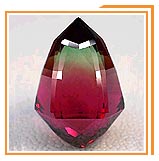
Unlike amethyst and topaz, tourmaline has escaped inordinate exploitation on the Brazilian market, probably because it is rarer and consequently more expensive. It is a mineral group of varying composition occurring in different colours, especially green, blue and grey. Pink specimens are known as rubellite.
Tourmaline has a deep brilliance and rich colouring. Transparent specimens being quite common, the stone is either cut en cabochon or faceted. Specimens with inclusions are used for beads.
Green tourmaline should not be confused with emerald, or red tourmaline with ruby. It has a wide distribution and is especially diffuse in Brazil and Madagascar.
![]()
| Name | Moh's | Specific Gravity | Structure | Cleavage | Refractive Index | Double | Disp. | Pleochro | Fluorescence |
| Tourmaline | 7+ | 3.02-3.26 | Hexagonal | None | 1.616-1.652 | -0.014 -0.044 | 0.017 | Definite to strong | Weak |